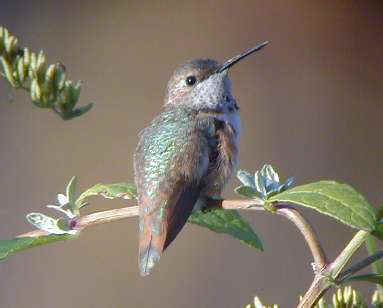 Rufous Hummingbird, Selasphorus rufus, Lenoir
Preserve, Yonkers, Westchester Co., NY, 23 November 2001.
Rufous Hummingbird, Selasphorus rufus, Lenoir
Preserve, Yonkers, Westchester Co., NY, 23 November 2001. Rufous Hummingbird, Selasphorus rufus, Lenoir
Preserve, Yonkers, Westchester Co., NY, 23 November 2001.
Rufous Hummingbird, Selasphorus rufus, Lenoir
Preserve, Yonkers, Westchester Co., NY, 23 November 2001.
All pictures were taken by my son Jay and me and are © Kevin J. McGowan. Most were taken with an Olympus D-450 digital camera through my Swarovski HD-80 spotting scope. The video captures were taken with a Sony TRV830 video camera.
On Saturday, November 17, 2001, Mike Bochnik discovered what appeared to be a Rufous /Allen's type Hummingbird at Lenoir Nature Preserve in Westchester Co., NY. (He has a few pictures posted off of the Hudson River Audubons Society page http://www.hras.org/). It was feeding on Pineapple Sage in the Hummingbird Garden. (Pineapple Sage Salvia elegans is native to the mountains of Mexico. It doesn't start to bloom till late October and can remain in bloom into December -barring a killing frost.) We were able to combine a family Thanksgiving get-together at my sister's house in New Rochelle with a hunt for an unusual New York bird (life bird for Jay; state bird for both of us), and went bright and early on Friday, 23 November. Although we had to wait a while for the bird to show up, it eventually did and allowed us to take some photographs.
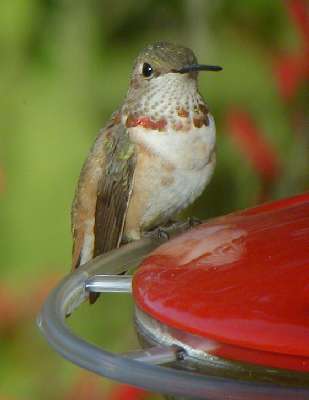 |
|
| The buffy flanks and sides of the chest, together with the rufous in the tail and over the back confirmed the bird as a Rufous/Allen's, and the scattering of red across the throat (not concentrated in a central spot) indicated an immature male. | |
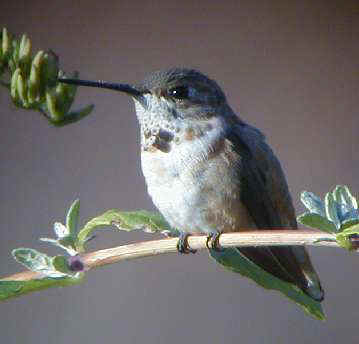
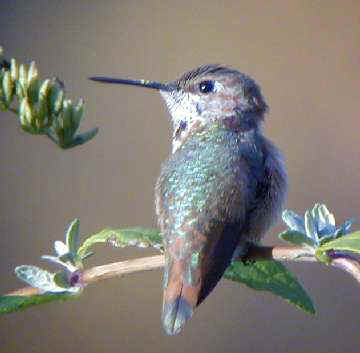
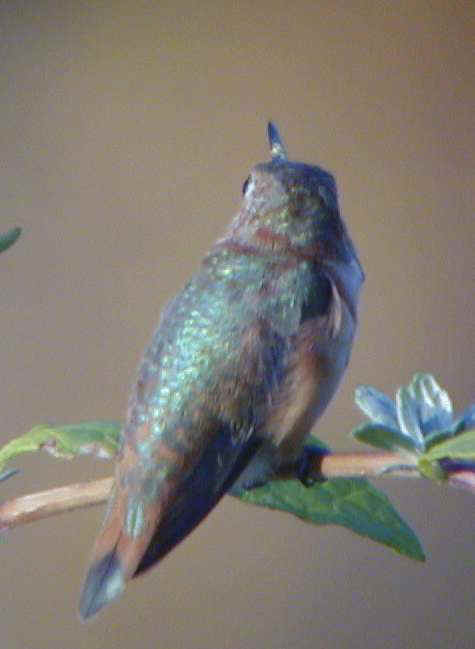 Notice the rufous edges to many of the back feathers, extending up onto the head.
While adult male Rufous Hummingbirds have rufous backs and heads and Allen's have green
there, immature male Allen's can have rufous on the back too (or so I am told).
Notice the rufous edges to many of the back feathers, extending up onto the head.
While adult male Rufous Hummingbirds have rufous backs and heads and Allen's have green
there, immature male Allen's can have rufous on the back too (or so I am told).
Separating the two species is difficult, and the best character is the width of the outermost tail feather (rectrix 5) (Rufous broader than Allen's) and the presence in Rufous of a slight notch in the next-to-middle tail feather (r2). Unfortunately, these are very difficult to see in the field. Still, with luck one can see the outer tail feather when the bird perches, and we hoped to capture some images on video to distinguish the two species.
Jay did pretty well with the still camera and scope, catching the following in-flight shots.
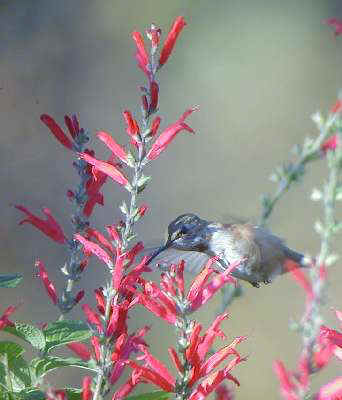
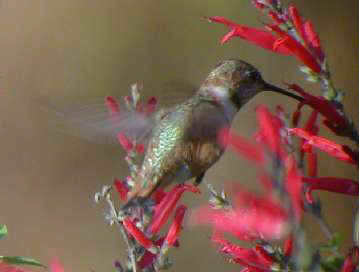
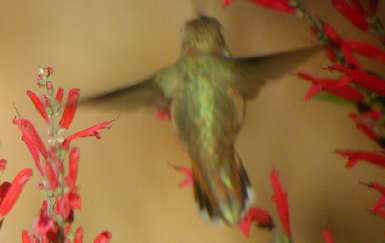 This last photo suggests a broad outer rectrix, especially on the right side. The
bird kept its tail furled whenever it was perched, but we got this photo showing the tail
from underneath, also indicating a rather broad outer feather.
This last photo suggests a broad outer rectrix, especially on the right side. The
bird kept its tail furled whenever it was perched, but we got this photo showing the tail
from underneath, also indicating a rather broad outer feather.
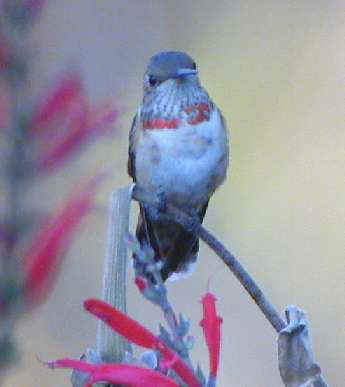
Fortunately the video camera is faster than we are, and we got a few shots of the bird in flight fanning its tail. I had no idea how fast hummingbirds fan their tails. I know hummingbirds are fast little buggers, but I hadn't had it quantified before. My camera takes 30 shots per second, and in every case the tail was fanned for exactly ONE frame!
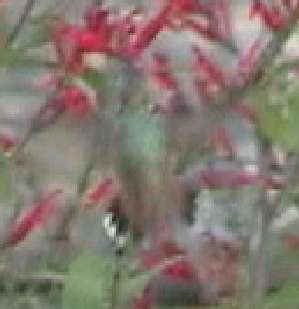 This one wasn't quite in focus, but the white-spotted tail feathers are apparent
(especially the left side), and the outermost one is as broad as the next two.
This one wasn't quite in focus, but the white-spotted tail feathers are apparent
(especially the left side), and the outermost one is as broad as the next two.
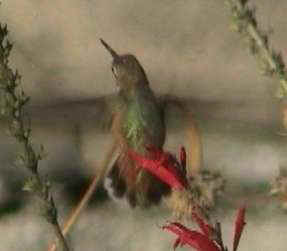 This was the best shot, and again shows a pretty broad outer feather.
This was the best shot, and again shows a pretty broad outer feather.
Occasionally the bird would flip its tail up, allowing a look at the underside of the feathers. Again, the outermost one looks broad, perhaps best seen in the magnified version of the second photo below.
.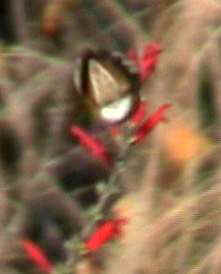
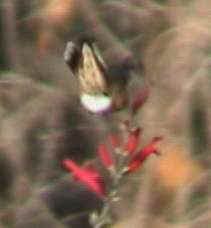
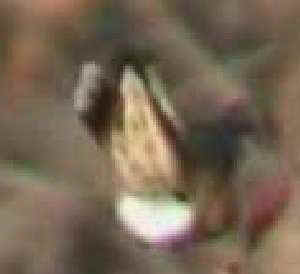
But, how broad is broad? I have to admit that I have not seen all that many Rufous and Allen's hummingbirds in my life (exactly one Allen's), and I do not have a good feel for how broad or narrow the outer feather should be. While field guides are great, I just don't trust paintings to represent subtle differences accurately. So, I went to the Cornell University Museum of Vertebrates to look at some specimens.
Allen's Hummingbird Selasphorus sasin. The following are shots of the tails of 3 Allen's Hummingbirds (unfortunately, none had data and the sexing was therefore not entirely trustworthy; museum folks trust sex only on specimens where the gonads had been examined during preparation).
The first two photos are of the same individual (CU5417), top and bottom. The outermost feather looks much narrower than the Yonkers bird.
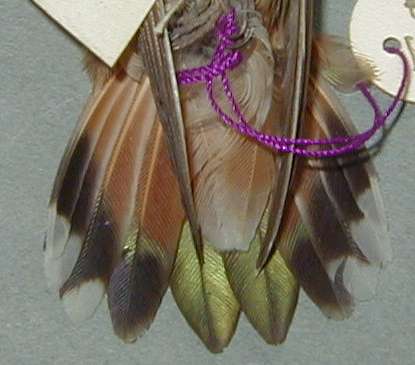
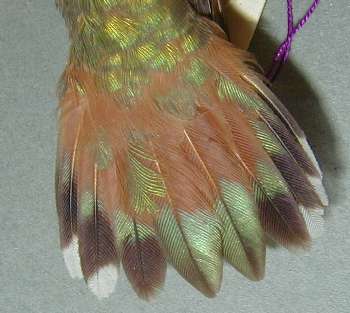
The same is true of the next two individuals (CU5418 and CU5416, respectively). Note that the outermost feather is missing on the bird's left side in the left photo (CU5418).
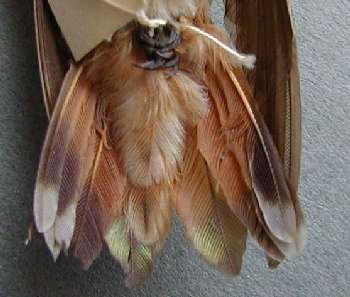
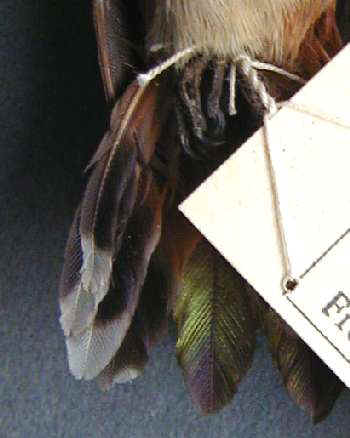
Rufous Hummingbird Selasphorus rufus. Both specimens show here are immature males. The first (CU5404) was collected in New Mexico, 10 August 1901.
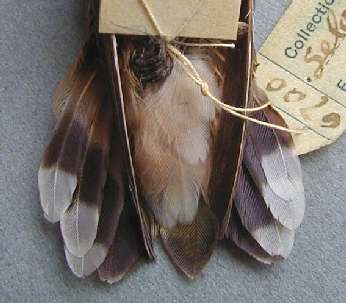
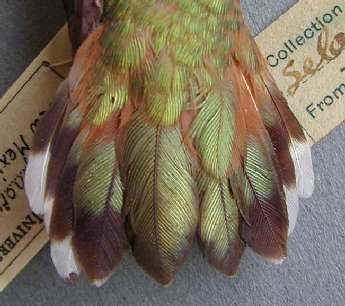
The next (CU11753) was collected in Arizona, 13 Aug 1940.
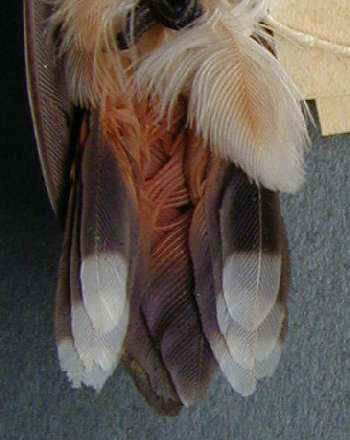 Both
specimens show noticeably broader feathers than the Allen's, and both are similar to
Yonkers bird. (Notice also that CU11753 has a broader outer feather on its left side
than its right!)
Both
specimens show noticeably broader feathers than the Allen's, and both are similar to
Yonkers bird. (Notice also that CU11753 has a broader outer feather on its left side
than its right!)
Compare also the next-to-middle tail feather shape. In the two Rufous Hummingbirds that feather is slightly indented on the inside side. On Allen's, it is not. Here is a blowup of the tail of CU5418 (Allen's) shown above.
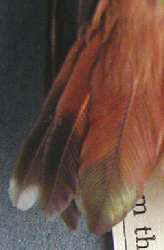 Remember that
the outermost feather is missing on this bird.
Remember that
the outermost feather is missing on this bird.
Here is a blowup of the best video capture show above. I can almost convince myself that I can see the notch on the bird's left side.
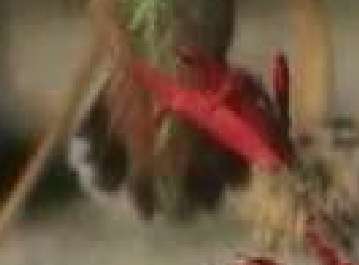
Therefore, we conclude the Lenoir hummingbird is indeed a Rufous Hummingbird.
Return to the Bad Photos page.
Return to Kevin McGowan's home page.
Go to the Crow Page.